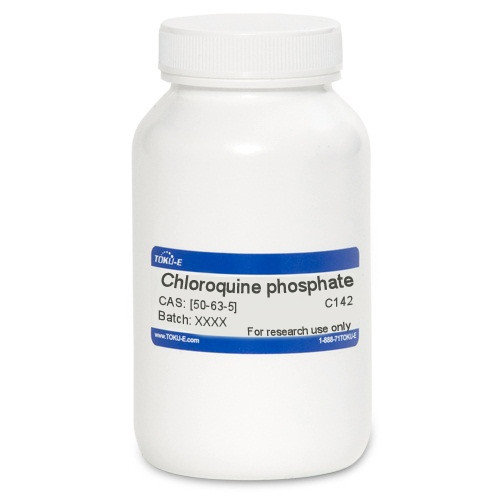Chloroquine Phosphate is a 4-aminoquinoline compound used to inhibit growth of malarial parasites. It is a weak intercalating agent. Chloroquine Phosphate can be used as a DNA interacalator and can be used to increase transfection efficiency. It has shown activity against SARS-CoV-2.
Chloroquine Phosphate is freely soluble in water, and very slightly soluble in ethanol and methanol.
| Mechanism of Action | Chloroquine enters a malarial parasite and binds to hemozoin, a non-toxic polymer formed from the parasite in an infected red blood cell. The chloroquine:hemozin complex interferes with normal membrane function leading to build-up of chloroquine:hemozin complexes and ultimately, cell lysis. |
| Spectrum | Chloroquine has been shown to be effective against parasites including Plasmodium vivax, Plasmodium malariae, and some strains of Plasmodium falciparum. Recently, Chloroquine Phosphate has shown activity against coronavirus (SARS-CoV-2). |
| Molecular Formula | C18H26ClN3 · 2H3PO4 |
| Identification | IR, UV, precipitate forms with picric acid solution that melts at 206-209°C, test for phosphates |
| Microbiology Applications | Chloroquine Phosphate has shown some activity against SARS-CoV-2 based on the findings of several clinical trials in China. Researchers found it can promote a virus-negative conversion and shorten the course of the disease. It has potential broad-spectrum antiviral activity by increasing endosomal pH. Since a low pH is required for the virus/cell fusion, by increasing the pH this can prevent virus replication. It can also interfere with the glycosylation of cellular receptors of SARS-CoV (Gao et al, 2020). |
| Eukaryotic Cell Culture Applications | Pompe disease is an autosomal disease caused by loss of glycogen-hydrolyzing enzyme acid alpha-glucosidase (GAA) activity, which results in glycogen accumulation in the lysozomes. GAA is responsible for hydrolyzing glycogen into free glucose within the lysosome. Chloroquine can be used to induce differentiation of induced pluripotent stem cells (iPS). To review autophagosomal turnover in the Pompe iPSC-CM model, authors forced autophagosome accumulation by blocking lysosomal acidification with Chloroquine (Raval et al, 2015). |
| Cancer Applications | Chloroquine can be used for autophagy inhibition in leukemia cells. Acute myeloid leukemia (AML) is characterized by the accumulation of immature blood cell precursors in the bone marrow. By overcoming this block in differentiation, one could prevent this condition. This was achieved in a subtype of AML called acute promyelocytic leukemia using the APL cell line NB4 (Orfali et al, 2015). |
| References |
Gao J, Tian Z and Yang X (2020) Breakthrough: Chloroquine Phosphate has shown apparent efficacy in treatment of COVID-19 associated pneumonia in clinical studies. Biosci Trends. 14(1):72-73 PMID 32074550 Orfali N et al (2015) Induction of autophagy is a key component of all-trans-retinoic acid-induced differentiation in leukemia cells and a potential target for pharmacological modulation. Exp. Hematol. 43(9):781-793 PMID 25986473 Raval KK et al (2015) Pompe disease results in a Golgi-based glycosylation deficit in human induced pluripotent stem cell-derived cardiomyocytes. J. Biol. Chem. 290(5):3121-3136 PMID 25488666 Sullivan, DJ et al (1996) On the molecular mechanism of Chloroquine's antimalarial action. PNAS 93 (1996):1865-1870 PMID 8876229 |








